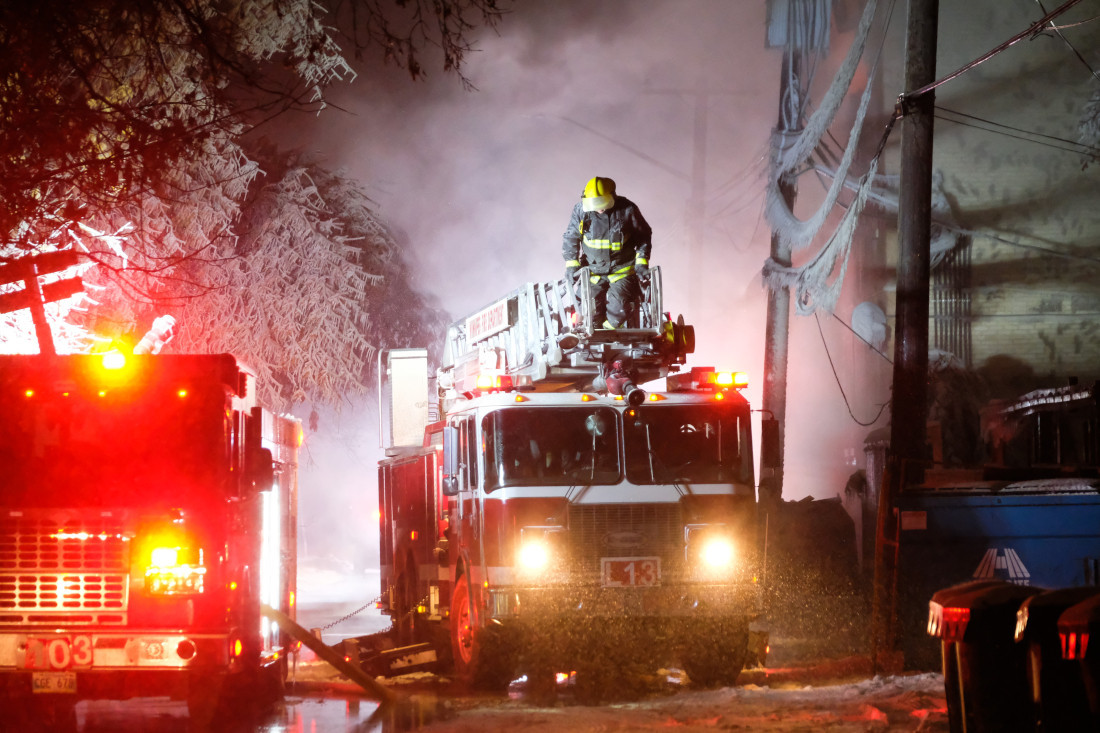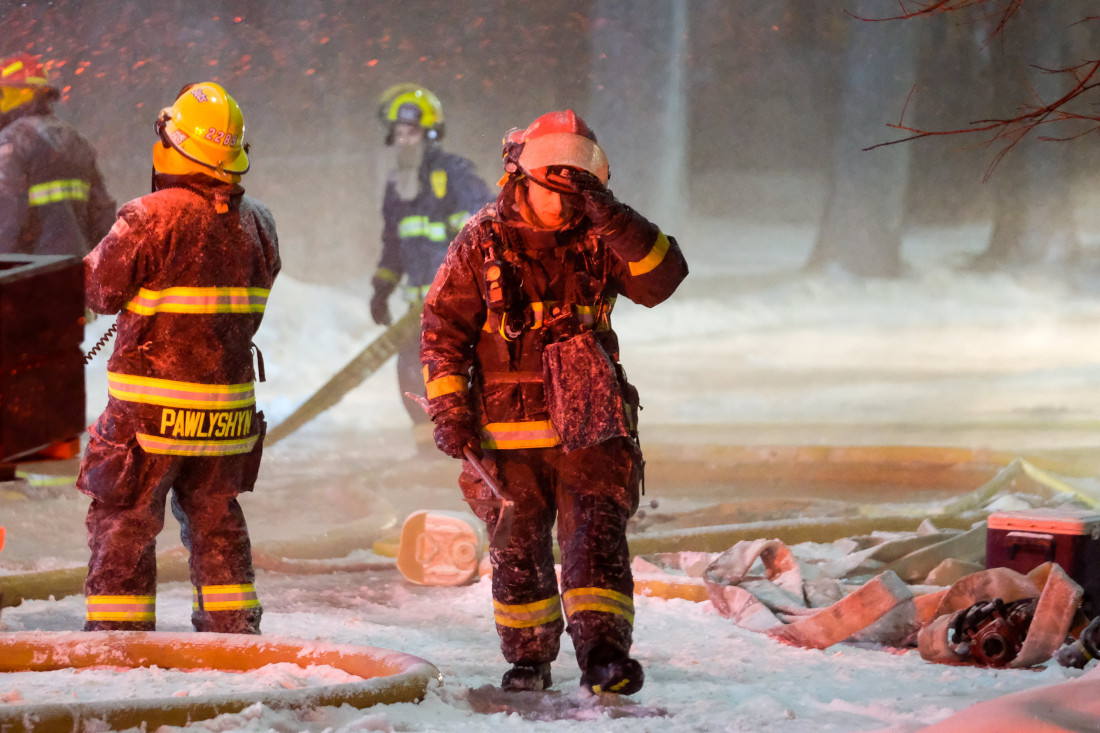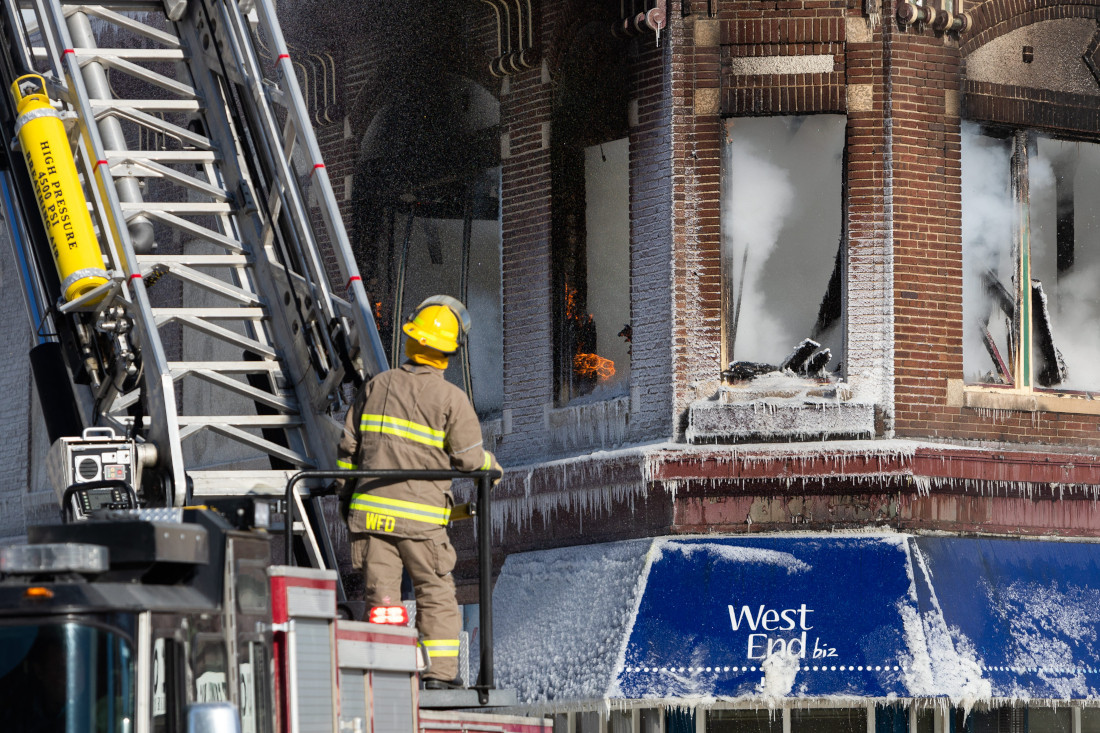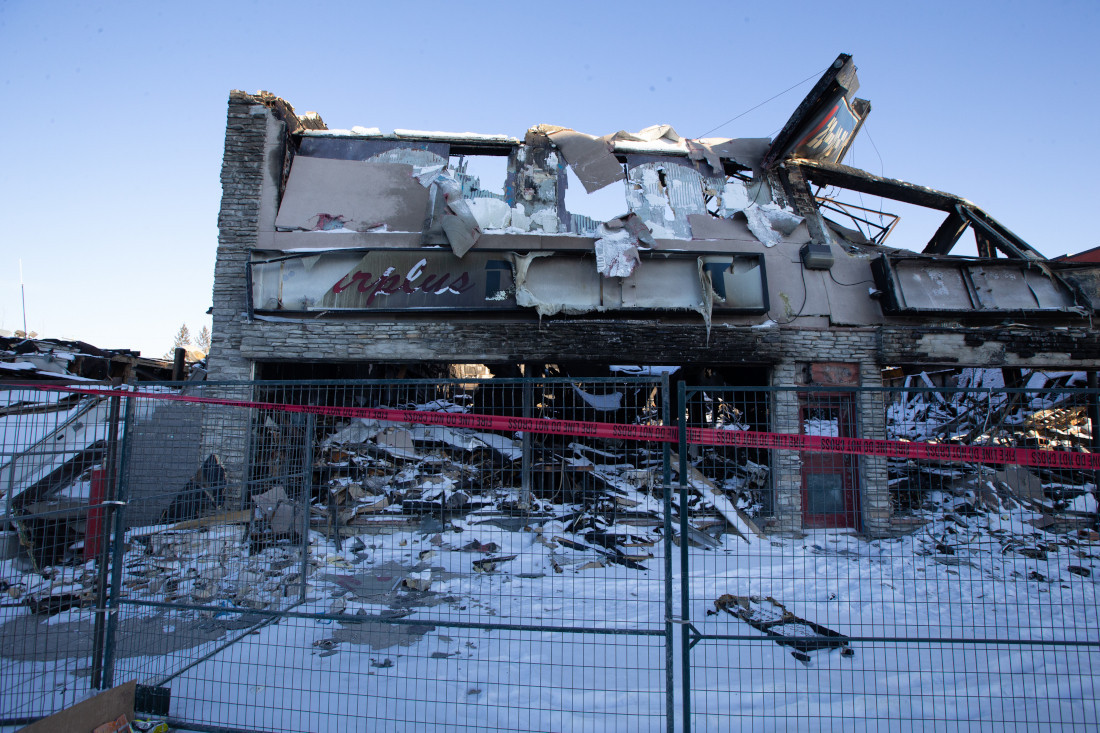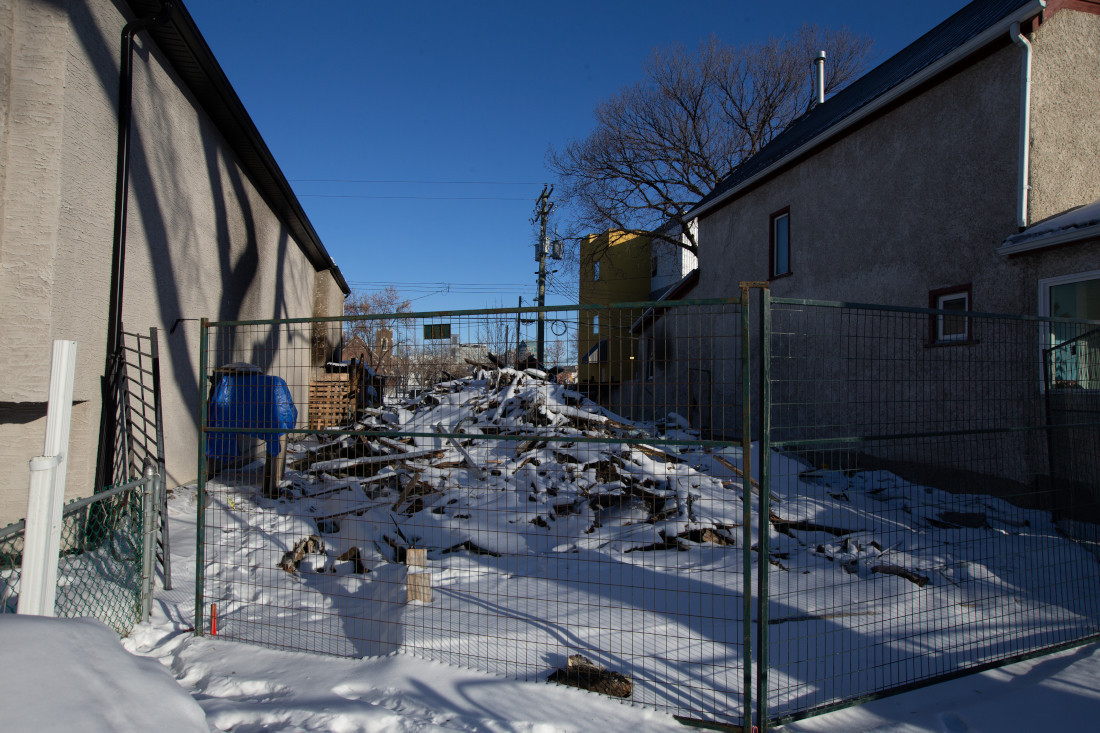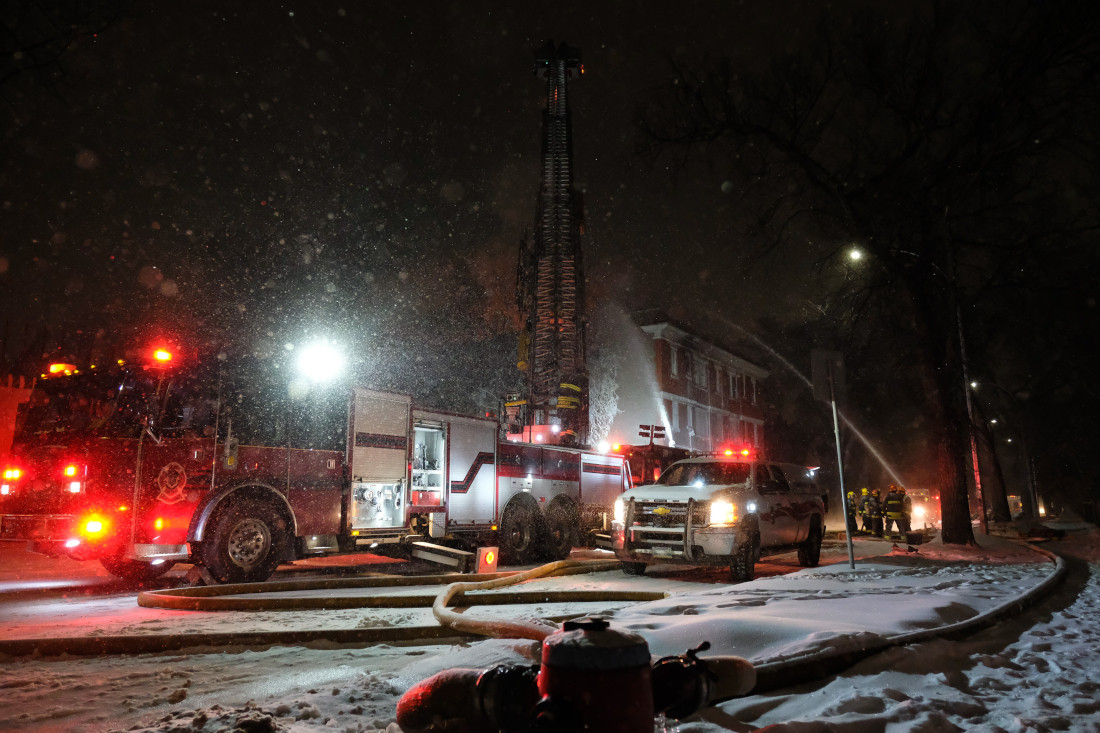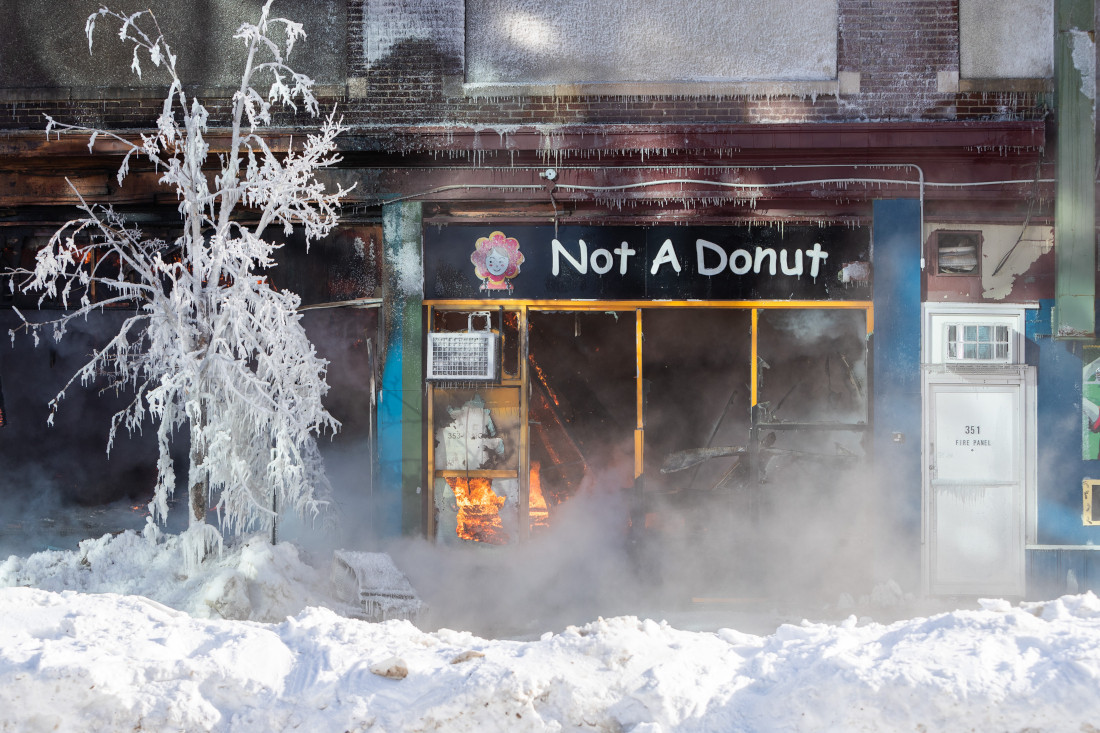Up in flames
The human impact of fires in Winnipeg
In the middle of the night on Saturday, Feb. 11, Point Douglas resident Candace-Rae Hamilton awoke to the sound of sirens.
“My room was filled with smoke,” she says. “I live alone with my cats. My neighbour across the hall has a heart condition.”
Residents of 15 homes along Austin Street and an apartment block on the corner of Jarvis and Main Street were promptly evacuated. A business in the 800 block of Main Street had gone up in flames, and the surrounding buildings were in danger of following suit.
The Winnipeg Fire Paramedic Service (WFPS) was on the scene just after 2 a.m., working through the night and into the morning with a crew of 50 personnel to extinguish the fire.
The fire started in Surplus Direct, a liquidation store on Main Street and soon spread to the neighbouring businesses: Lord Selkirk Furniture and Top Pro Roofing Ltd. Though the WFPS’s goal was to contain the fire, Assistant Chief Scott Wilkinson says the interconnected businesses and combustible materials inside made this challenging, as crews couldn’t enter the buildings.
“Our goal was to keep it out of the neighbouring properties, but that proved impossible, and we did see fires spread to both of those buildings,” he explains.
The crews approached the fire from outside and stopped the flames from reaching the adjacent apartment block on the corner of Jarvis and Main Street.
They “did a tremendous amount of work,” Wilkinson says, noting that three firefighters went to the hospital with minor injuries but were all released the same day.
It’s more than the buildings lost
Catastrophic fires mark pivotal moments in the city’s history. In 1904, the basement of the Bulman Block erupted in flames, causing an infamous fire in the Exchange District, spreading to the Ashdown Hardware Store and the Woodbine Hotel. In 1954, the Times Building burned. In 1968, the Saint Boniface Cathedral. In 1999, the Leland Hotel. The list goes on.
But conversations about heritage buildings lost to fires sometimes disregard the systemic issues that can cause them and the devastating human impact they leave in their wake.
There were no fatalities in the recent fire on Main Street, nor were any notable architectural staples of the neighbourhood lost, but the community has sustained substantial damage.
Surplus Direct, Lord Selkirk Furniture and Top Pro Roofing are expected to be a total loss. All three businesses have been in the community for years (Lord Selkirk opened in 1976, Surplus Direct in 1991 and Top Pro in 2012). Residents of the Enright Block on Jarvis Avenue have been supported by social services to find temporary housing. At press time, they are unable to return to their homes due to significant water and smoke damage in the building.
Hamilton says the Austin Street residents are also struggling to deal with the fallout from that night. When the houses were deemed safe to return to around 7 a.m., there was still smoke in her halls.
“It lingers to this day,” Hamilton says, explaining that while the smoke itself is gone, the smell has permeated her bedding and clothes.
Hera Nalam, a St. Boniface resident, experienced a fire in her building a few weeks ago and knows firsthand about the anxiety these events can cause. Although she lives on an upper floor and this fire happened in the basement, fire personnel evacuated the entire house in the middle of the night.
Nalam remembers the basement tenant “coming in and out ... trying to move everything as far from the fire as possible. I’m pretty sure he inhaled a bunch of toxic fumes in there.”
When she later entered the basement suite, she noticed that some of the walls were “significantly different” due to smoke damage, and the linoleum in the bathroom where the fire had occurred had completely melted.
The night of the fire, Nalam and her roommate discussed renter’s insurance. She says the tangible threat fires pose to peoples’ belongings and sense of safety and stability is substantial.
Hamilton says that, at this time, she isn’t receiving any financial support to help with cleaning, as she tries to rid her belongings of the smell of smoke. She hoped to receive support from the Employment and Income Assistance program or the Red Cross but so far has been unsuccessful. Her neighbour who has a heart condition has been relocated to a hotel.
Evidently, fires touch more than those directly affected by them, damaging buildings and surrounding communities as a whole. In addition to physical damage and the loss of belongings, many people are forced to reckon with their pre-existing health and financial issues. Without familial support some savings or access to money, and the ability to advocate for oneself within the system, navigating the fallout of a fire can be incredibly challenging, frustrating and complicated.
Fires are on the rise
Though Winnipeg hasn’t seen a catastrophe like the Bulman Block fire for many years, fires are actually on the rise across the city.
A report from the City of Winnipeg showed a 4.4 per cent increase in building fires between January 2019 and January 2022 and a 58 per cent rise in all fires, the majority of which fell into the “non-structure” category, including grass and trash fires. Though part of this upswing could be attributed to drought and extreme cold, experts have connected fires to socioeconomic issues such as poor housing conditions and vacant buildings.
The city has not provided updated data this year, but Wilkinson confirms that Winnipeg “tends to have quite a high number of fires per capita in comparison to other jurisdictions.”
Fires are a consistent problem across the city, he says, but the WFPS responds to “a higher number of fire incidents in certain neighbourhoods, including the North End.”
West Broadway Community Organization (WBCO) executive director Kelly Frazer says buildings that are inadequately heated, especially rooming houses, are more likely to experience fires. The West Broadway community has lost several rooming houses to fires over the past number of years.
“If there is no heating in a house, the government will step in and it gets emergency status, and it is dealt with rather quickly,” she explains. However, when heat is present but insufficient, tenants often resort to measures like turning on the stove or using electrical space heaters to stay warm.
Especially in older homes, “if the owner hasn’t taken steps to upgrade the insulation, it can be really uncomfortably cold, even if you are spending a lot on heat,” Frazer says.
“The properties I can think of in this neighbourhood that have had significant fires were those where the rent was very low, but the owners were not necessarily reinvesting into the property ... You don’t see them in well-run rooming houses.”
Vacant buildings are at risk
Frazer points out that when buildings become so run down that no one wants to invest in them at all, they become vacant, which poses other risks. This isn’t necessarily an issue in West Broadway, but it’s common in the West and North Ends, which see a significant number of fires in vacant buildings, usually during illegal entry.
Just two days after the fire on Main Street, on the morning of Feb. 13, firefighters responded to a call about a vacant-building fire in a previously burnt property on Victor Street in the West End. On the scene, the house was deemed structurally unstable and was partially demolished to extinguish the remaining fires inside.
Wilkinson explains that the WFPS often opts to demolish partially burned vacant buildings so they no longer cause a threat to surrounding homes. The WFPS responds to calls about vacant buildings in certain areas, including the North End, “on a very regular basis,” he says.
Cindy Tugwell, executive director of Heritage Winnipeg has also identified a trend of vacant buildings burning in the North End. She says the homes that are demolished as a result of these fires are “typically older homes ... and I would argue that many are built very well.”
Tugwell agrees that if a structure is a fire hazard, demolition is necessary to keep the surrounding houses and communities safe. Ideally, though, she’d like to see more preventative measures to reduce fire risk factors in the first place.
Some changes are already underway. To encourage property development and dissuade owners from sitting on vacant properties, the City of Winnipeg has recently amended the vacant-buildings bylaw, introducing a clause that says property owners could be charged upwards of $12,000 whenever emergency crews respond to a fire in a vacant building.
However, this might not be enough. The City has reported monitoring 666 vacant buildings, but only 63 of them have active permits. To effectively dissuade people from failing to maintain and secure vacant properties, the City needs to enforce all parts of the bylaw.
Tugwell says Heritage Winnipeg would like to get down to the “nitty gritty” of which buildings are vacant and why.
But, according to a City representative, this information cannot be released for security reasons. Though Tugwell understands why it is not available to the general public, she wants the City to release the list to community partners and stakeholders.
“We need to know why these properties are vacant” before solutions can be reached, she says.
Preventing fires and rebuilding communities
Wilkinson says the WFPS continues to reassess “standards for building, boarding and securement, because that’s a key issue in preventing fires.”
Tugwell would like to see the City collaborate with community partners to incentivize owners to rehabilitate older homes, possibly working with the Canada Mortgage and Housing Corporation (CMHC) to get unsecured, vacant properties out of the hands of disinterested owners.
Rather than letting buildings reach vacant status, Tugwell says the properties should be repurposed as affordable housing. “I would love to see those properties reused, not sitting ducks for a fire and then eventually demolished.”
That said, the WFPS will continue to address fire hazards on a case-by-case basis. As Wilkinson points out, fires are not contingent on any one specific risk factor, but a vast array of contributing factors at any given time.
Accidental fires caused by electrical failures, smoking and unattended cooking tend to be their “top three,” he says, closely followed incendiary fires. Though these problems can certainly occur in higher-income areas, the relationship between fire risks and poor socioeconomic conditions is undeniable.
It’s a problem, Tugwell says, that is intimately related with housing insecurity that disproportionately affects residents of certain Winnipeg neighbourhoods, including the North End.
“If you had as many fires as are happening in the north happening in the south, how many would burn before people would be outraged?” she asks. “I think we just accept that properties in the North End should be vacant, and they should be boarded up. And my question to the City is why?”
Published in Volume 77, Number 20 of The Uniter (March 2, 2023)

